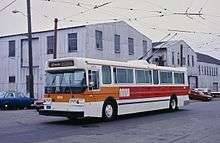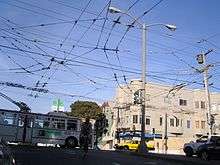Trolleybuses in San Francisco
| San Francisco trolleybus system | |
|---|---|
|
XT60 trolleybus on route 5 in December 2017 | |
| Operation | |
| Locale | San Francisco, California, United States |
| Open | 1935 |
| Status | Open |
| Operator(s) |
Market Street Railway (1935–1944) San Francisco Municipal Railway (1941–present) |
| Infrastructure | |
| Electrification | 600 V DC parallel overhead lines |
| Stock | approx. 300 |
| Website | San Francisco Municipal Railway |
.jpg)
The San Francisco trolleybus system forms part of the public transportation network serving San Francisco, in the state of California, United States. Opened on October 6, 1935,[1] it presently comprises 15 lines, and is operated by the San Francisco Municipal Railway, commonly known as Muni (or the Muni), with around 300 trolleybuses. In San Francisco, these vehicles are also known as "trolley coaches", a term that was the most common name for trolleybuses in the United States in the middle decades of the 20th century.
The Muni trolley bus system is complementary to the city-owned Muni bus services, Muni Metro and cable car system and the rail-bound regional Caltrain and Bay Area Rapid Transit systems. In addition, it shares some of its overhead wires with the F Market & Wharves streetcar line.
One of only five such systems currently operating in the U.S.,[2] the Muni trolley bus system is the second-largest such system in the Western Hemisphere, after that of Mexico City.
History

Long a hub of streetcar development, San Francisco had much of the infrastructure necessary to instate trolleybus service already existing on city streets. In 1941, Muni introduced its first trolleybus line: the R-Howard line. Trolleybuses had been running in San Francisco since 1935, but operated only by the Market Street Railway Company, successor to the URR. By 1944, the MSR was in financial difficulties. Thus, at 5 am on September 29, 1944, Muni acquired its commercial competitor. Along with the routes and equipment, Muni adopted its competitor's more expensive seven-cent fare ($1.16 adjusted for inflation).[3] Following national trends, Muni replaced most of its rail lines with trolleybus service in the succeeding decades. A few lines with dedicated rights-of-way (including those serving the Twin Peaks and Sunset tunnels) continued as rail lines running 1940s-era PCC streetcars through the 1970s. Those lines became the foundation of the Muni Metro. While many municipalities further converted their trolleybus systems to diesel buses during the middle of the 20th century, San Francisco maintained trolleybuses due to their ability to climb the city's steep hills and because electricity was available at extremely low cost from the city-owned O'Shaughnessy Dam.[4]
Lines

Trolley buses currently operate the following Muni routes:[5]
| Line | Routing | Division | Notes |
|---|---|---|---|
| 1 California | Drumm Street – California Street – 33rd Avenue/Geary | Presidio | |
| 2 Clement (Short turn) | Ferry Plaza – Sutter Street – Presidio Avenue | Presidio | Only short turn buses, operated during weekday peak hours, are operated with trolley coaches. |
| 3 Jackson | Sutter Street – Jackson Street – Presidio Avenue | Presidio | |
| 5 Fulton | Transbay Terminal – Fulton Street – La Playa/Ocean Beach | Potrero | Trolley coaches used during weekend and weekday hours when 5R is not in operation. |
| 5R Fulton Rapid | Operates weekdays 7am-7pm using articulated 60 foot trolleybuses | ||
| 6 Haight-Parnassus | Ferry Plaza - Haight Street – Parnassus Street – Quintara Street | Presidio | |
| 14 Mission | Ferry Plaza – Mission Street – San Jose Avenue/Daly City | Potrero | |
| 21 Hayes | Ferry Plaza – Hayes Street – Stanyan/Fulton | Presidio | |
| 22 Fillmore | 3rd St./20th – Fillmore Street – Marina Boulevard | Potrero | Construction starts in fall 2018 for re-routing to Third Street in Mission Bay[6] |
| 24 Divisadero | Jackson Street – Divisadero Street – Oakdale/Palou/3rd Street | Presidio | |
| 30 Stockton | Caltrain Depot – Stockton Street – Jefferson Loop | Potrero | |
| 31 Balboa | Ferry Plaza – Balboa Street – La Playa/Ocean Beach | Presidio | |
| 33 Ashbury-18th Street | Maple Street – Ashbury Street - 18th Street – Potrero/25th Street | Presidio | |
| 41 Union | Lyon/Greenwich - Union Street – Columbus Avenue – Howard/Main | Presidio | Operates only during rush hour. |
| 45 Union-Stockton | Lyon/Greenwich - Union Street – Stockton Street – Caltrain Depot | Presidio | |
| 49 Van Ness-Mission | North Point Street – Van Ness Avenue – Mission Street – City College | Potrero | Dieselized until 2021 due to Van Ness Bus Rapid Transit construction.[7] |
Fleet
Past fleet (though 2015)

Since its opening in 1935 (Market Street Railway system), the fleet of the San Francisco trolleybus system has included trolleybuses built by several different manufacturers, including the J. G. Brill Company, the St. Louis Car Company, Marmon-Herrington, Twin Coach and Flyer Industries (now New Flyer).
By January 2010, the exclusively high-floor Muni trolley bus fleet included 313 serviceable vehicles, comprising three different types, of which 240 were conventional length (two-axle) buses and 73 articulated buses.[5][8] Of the latter, 40 were New Flyer E60 vehicles (built in 1993–94); 12 of these were retired in early 2013,[9] and the remaining 28 were retired in early January 2015.[10] All of the then-remaining 273 trolleybuses were built by Electric Transit, Inc. (ETI), mostly in 2001–03, the 240 40-foot units being model 14TrSF and the 33 articulated units being model 15TrSF. The suffix SF in the two ETI model numbers stands for San Francisco. These two types were specially derived from the Škoda 14Tr and 15Tr for use on the Muni system.
An order was placed in 2014 for 60 New Flyer XT60 articulated vehicles, the system's first low-floor trolleybuses. Two prototypes (Nos. 7201 and 7202) arrived in March 2015 and May 2015, respectively,[11] and entered service in May[11] and September 2015.[12] Delivery of the 58 production-series vehicles began in September 2015, and the series entered service between November 2015[12] and July 2016. They replaced the 33 ETI 15TrSF articulated trolleybuses, the last of which were retired in April–May 2016. These changes left the current fleet with the 240 conventional units built by ETI (model 14TrSF) and 60 New Flyer XT60s.
Current fleet
The present fleet includes 40-foot (12 m) trolleybuses and 60-foot (18 m) articulated trolleybuses.
| Fleet numbers | Quantity | Manufacturer | Propulsion | Model | Configuration | Year built | Notes |
|---|---|---|---|---|---|---|---|
| 5401–5640 | 240 | Electric Transit, Inc. (ETI) (Škoda/AAI Corp.) | Škoda Electric | 14TrSF | Conventional | 1999 (first two), 2001–2003 | 65 coaches retired.
Presidio division: 5485-5640 Potrero division: 5401-5484 |
| 7201–7260 | 60 | New Flyer | Vossloh Kiepe | XT60 | Articulated, low-floor | 2015–2016 | All assigned to Potrero division |
| 7261–7293 | 33 | New Flyer | Kiepe Electric | XT60 | Articulated, low-floor | 2017–2018 | Option exercised in mid-2016.[13] Delivery under way since October 2017. |
| 5701–5885 | 185[14][15] | New Flyer | Kiepe Electric | XT40 | Conventional, low-floor | 2018–2019 | Delivery under way since February 2018 |
In 2013, the SFMTA adopted plans for an eventual one-for-one replacement of the existing trolleybus fleet in a joint agreement with King County Metro and New Flyer over technical specifications and pricing.[16] The first order to be placed under the 2013 agreement was the 2014 order for 60 articulated trolleybuses, delivery of which began in 2015.[11] In July 2016, an order for an additional 33 articulated vehicles was placed,[13] and the final procurement under the 2013 agreement was an order for 185 two-axle, 40-foot New Flyer XT40 trolleybuses, which received final approval in June 2017.[15] These vehicles will replace the remaining ETIs. Muni has options for an additional 55 XT40 trolleybuses, but is not planning to exercise them, because the number of articulated trolleybuses in Muni's fleet has recently been expanded.[17]
Grade
Particularly notable of San Francisco's trolley bus operations are very steep grades. The system includes the single steepest known grade on any existing trolley bus line in the world,[18][19][20][21] specifically 22.8% in the block of Noe Street between Cesar Chavez Street and 26th Street on route 24-Divisadero,[18][20][22] and several other sections of Muni trolley bus routes are among the world's steepest.[23]
Infrastructure
- Market Street Railway (overhead lines)
- Stockton Street Tunnel
- Van Ness Bus Rapid Transit (2020)
See also
References
Notes
- ↑ "History of Trolley Buses in San Francisco". San Francisco Municipal Railway. Archived from the original on December 18, 2011. Retrieved December 24, 2014.
- ↑ Webb, Mary (ed.) (2013). Jane's Urban Transport Systems 2013–2014, pp. "[23]" and "[24]" (in foreword). Coulsdon, Surrey (UK): Jane's Information Group. ISBN 978-0-7106-3080-3.
- ↑ "Trolley Bus History". San Francisco Municipal Railway. Archived from the original on December 18, 2011. Retrieved December 23, 2007.
- ↑ Perles, Anthony (1981). The People's Railway: The History of the Municipal Railway of San Francisco. Interurban Press. p. 176. ISBN 0916374424.
- 1 2 "Trolleybus city: San Francisco (USA)". Trolleymotion. Retrieved December 24, 2014.
- ↑ SFMTA. "16th Street Project Spring 2018 Update". Retrieved 2018-07-01.
- ↑ "Van Ness Avenue Bus Rapid Transit". San Francisco County Transportation Authority. Retrieved February 23, 2017.
- ↑ Trolleybus Magazine No. 293 (September–October 2010), p. 116. National Trolleybus Association (UK). ISSN 0266-7452.
- ↑ Trolleybus Magazine No. 309 (May–June 2013), p. 82.
- ↑ Trolleybus Magazine No. 320 (March–April 2015), pp. 62–63.
- 1 2 3 Trolleybus Magazine No. 322 (July–August 2015), p. 126.
- 1 2 Trolleybus Magazine No. 325 (January–February 2016), p. 31.
- 1 2 Trolleybus Magazine No. 329 (September–October 2016), p. 159.
- ↑ Rodriguez, Joe Fitzgerald (April 18, 2017). "Muni's worst clunker buses to be replaced for big price tag: $244M". San Francisco Examiner. Retrieved 2017-05-09.
- 1 2 "San Francisco MTA to add 185 40-foot trolley buses". Metro Magazine. June 15, 2017. Retrieved June 15, 2017.
- ↑ Metro to partner with New Flyer on next generation of electric trolley buses June 17, 2013. King County Metro.
- ↑ Trolleybus Magazine No. 335 (September–October 2017), p. 197. National Trolleybus Association (UK). ISSN 0266-7452
- 1 2 Perles, Anthony (1984). Tours of Discovery: A San Francisco Muni Album. Interurban Press. p. 127. ISBN 0-916374-60-2.
- ↑ Box, Roland (May–June 1989). "San Francisco Looks Ahead". Trolleybus Magazine No. 165, pp. 50–56. National Trolleybus Association (UK).
- 1 2 Trolleybus Magazine No. 261 (May–June 2005), p. 72.
- ↑ Trolleybus Magazine No. 313 (January–February 2014), p. 27.
- ↑ "General Information About Transit". San Francisco MTA. 2012. Archived from the original on January 28, 2013. Retrieved July 24, 2016.
- ↑ Trolleybus Magazine No. 259 (January–February 2005), p. 23.
Books
- Perles, Anthony; with John McKane; Tom Matoff; Peter Straus (1981). The People's Railway: The History of the Municipal Railway in San Francisco. Glendale: Interurban Press. ISBN 0-916374-42-4.
External links
| Wikimedia Commons has media related to Trolleybuses in San Francisco. |
- San Francisco Municipal Railway - official website
- Muni's Trolley Bus History